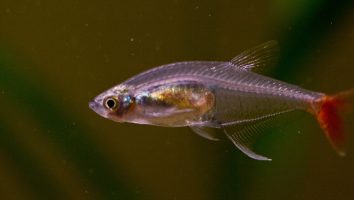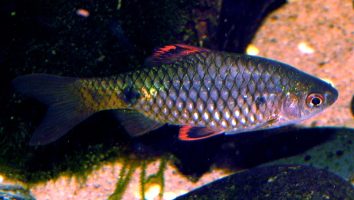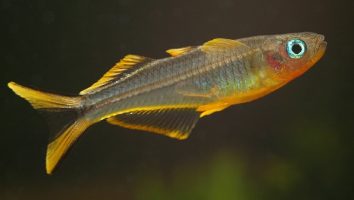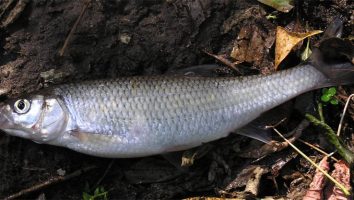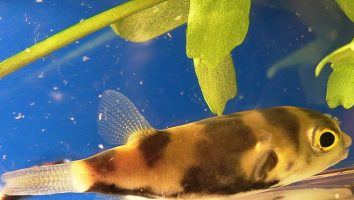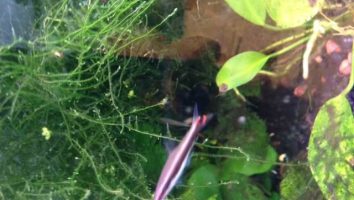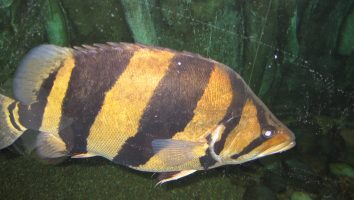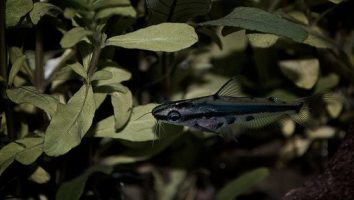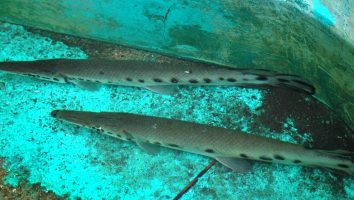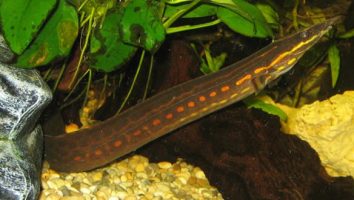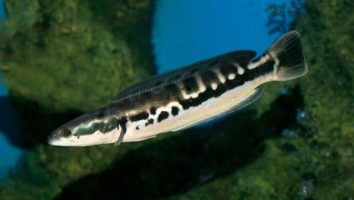The banded archerfish is a freshwater fish that is native to Australia and Southeast Asia. They get their name from their unique ability to shoot down prey with a stream of water.
This fish is a great addition to any freshwater tank. They are interesting to watch and are not very demanding in terms of care.
In this guide, we will go over everything you need to know about banded archerfish care. We will cover topics such as diet, tank mates, and more.
Table of contents
Species overview
Banded archerfish (Toxotes jaculatrix) are a type of freshwater fish that’s found throughout Southeast Asia in countries like Thailand, Vietnam, Malaysia, and Indonesia.
They are most commonly found near rivers and streams where there is a lot of vegetation. This is because they primarily eat insects that live among the plants.
Banded archerfish get their name from their unique hunting style. They are able to shoot a stream of water at insects that are up to 3 meters away! This is an amazing feat considering their size.
These fish are very popular in the aquarium trade and are considered to be one of the best freshwater fish for beginners. This is because they are very hardy and can adapt to a wide range of water conditions.
Appearance
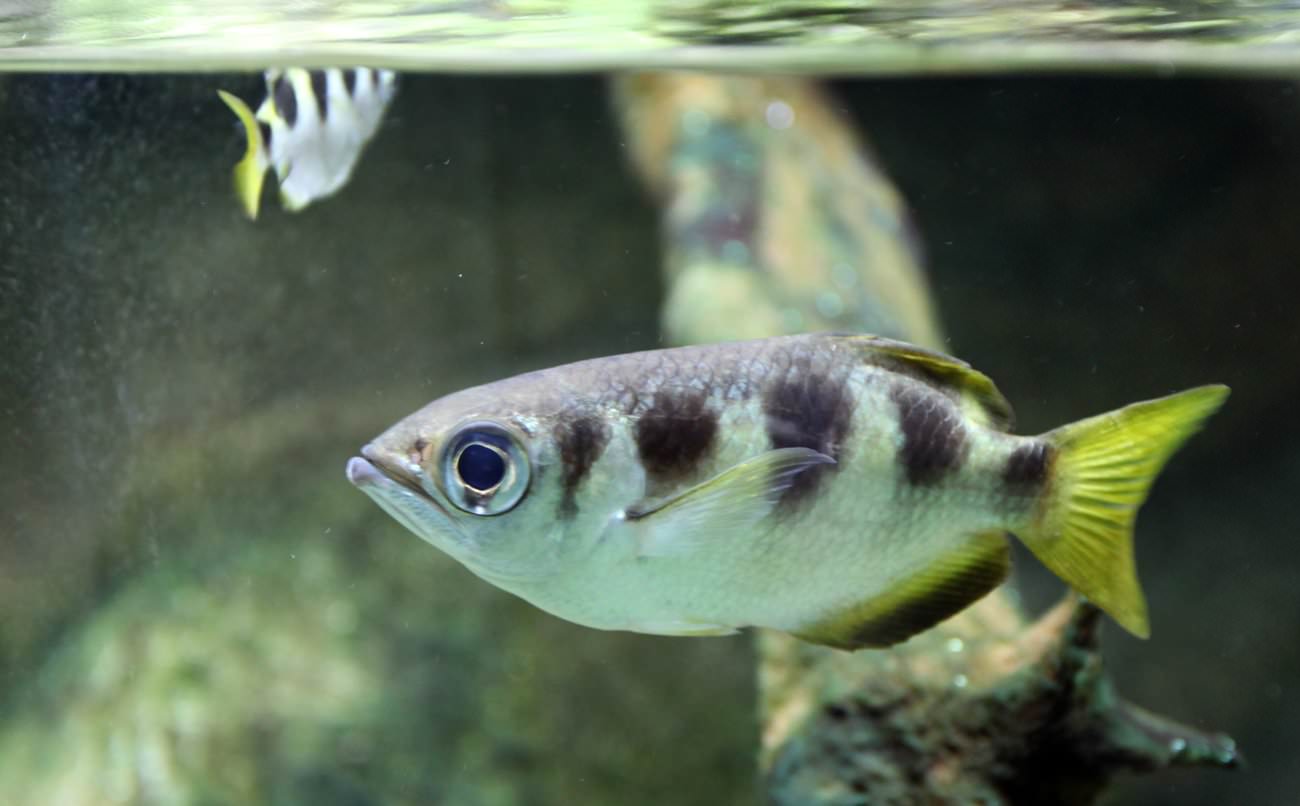
The Banded Archerfish is an unique-looking fish that is easily recognizable. They have a long, thin body that is silver in color with dark vertical bands running down their sides.
The bands on their sides are black or dark brown and they’re relatively thick. They start right behind the gill covers and stop right before the caudal peduncle.
The Banded Archerfish also has a long dorsal fin that starts just behind their head and runs almost the entire length of their body. This fin has 13-17 soft rays and is dark in color, usually matching the bands on their sides.
Their caudal fin is forked and also dark in color. The Banded Archerfish has a small mouth that is filled with small, sharp teeth.
They also have two long barbels on their lower jaw that they use to help them find food.
The Banded Archerfish can grow to be about 12 inches (30 cm) in length.
Lifespan
The banded archerfish has a lifespan of around 4 to 6 years. This lifespan can be increased by providing them with optimal care. This includes a clean and well-maintained tank, a healthy diet, and tank mates that won’t stress them out.
Size
These fish can get pretty big, with some specimens reaching up to 2 feet in length! However, the average size for a Banded Archerfish is usually between 12 and 18 inches.
Tank
Tank Size
The recommended tank size for banded archerfish is 75 gallons. These fish are active swimmers and jumpers, so you need to provide them with plenty of space.
They’re also known to be aggressive towards other fish, so it’s best to keep them in a tank by themselves or with other fish that can hold their own.
Water Parameters
The banded archerfish is a tropical freshwater fish that is native to the brackish waters of Southeast Asia. In the wild, these fish are found in mangrove swamps, estuaries, and rivers.
The banded archerfish is a very hardy fish that can adapt to a wide range of water parameters. However, for optimal health and to prevent stress, it is best to maintain the following water parameters:
- Water temperature: 72 to 82 degrees Fahrenheit
- pH levels: 6.8 to 7.6
- Water hardness: 5 to 15 dGH
- Alkalinity Levels: 4-8 dKH
What To Put In Their Tank
Banded Archerfish are a freshwater species that come from Southeast Asia.
They’re known for their unique ability to shoot water at prey above the surface of the water in order to knock it down.
While they’re not the most common fish you’ll find in the home aquarium, they can make for a very fun and interesting addition to your setup.
The first thing you need to take into account when setting up a tank for Banded Archerfish is that they need a lot of space. A single fish needs at least a 50-gallon tank, and we recommend going up to at least 75 gallons if you’re planning on keeping more than one.
The next thing to consider is the fact that these fish like to have plenty of hiding spots. This can be in the form of plants, rocks, or driftwood.
They also need some open space to swim, so don’t go overboard with the decorations. A good rule of thumb is to decorate the tank in a way that leaves about 60% of the surface area unobstructed.
Finally, the substrate isn’t something you need to be too picky about. They’re not a fish that spends a lot of time rooting around, so anything from gravel to sand will work just fine.
Common Diseases
The banded archerfish is a hardy and disease-resistant fish. They’re not immune to disease, but they don’t seem to be as susceptible as some other freshwater species.
The most common problems that these fish experience are parasites and infections. Ich is by far the most common, but there are a few other potential parasites that can affect your fish.
The best way to keep your banded archerfish healthy is to maintain clean and stable water conditions in their tank. This will help to keep them disease-free and will also make them less susceptible to stress (which can also lead to illness).
As always, be on the lookout for any abnormal behavior or changes in your fish. If you notice anything out of the ordinary, consult your vet and begin treatment immediately.
Behavior & Temperament
The Banded Archerfish is a peaceful community fish that does well in groups. They are not known to be fin nippers and can even be kept with long-finned species. They are, however, known to be jumpers, so a tight-fitting lid is a must.
Banded Archerfish are shy fish when first introduced to an aquarium. They will often spend the majority of their time hiding until they feel comfortable in their new surroundings. Once they adjust, they will become more active and will even start to show their unique hunting behaviors.
Banded Archerfish are surface hunters that use their keen eyesight and accuracy to shoot down prey with a stream of water. They have been known to shoot down insects as large as a dragonfly!
Tank Mates
The best tank mates for banded archerfish are other fish that occupy different parts of the water column.
Banded archerfish are surface dwellers. They spend most of their time near the top of the tank where they can ambush their prey. As a result, you don’t want to add fish that share this trait.
The good news is that there are plenty of fish that occupy different parts of the water column. This provides plenty of options when stocking your tank.
Some good banded archerfish tank mates include:
- Clown Loach
- Kuhli Loach
- Black Skirt Tetra
- Honey Gourami
- Bloodfin Tetra
- Silver Dollar Fish
- Sparkling Gourami
- Green Terror Cichlid (as long as you have enough space)
- Pearl Gourami
- Congo Tetra
Breeding
Banded archerfish are not easy to breed in captivity. In the wild, they lay their eggs in the shoots of plants that grow in brackish water. In captivity, you will need to recreate this environment as best as you can.
The first step is to set up a breeding tank. It should be at least 30 gallons and filled with brackish water. The water should have a salinity of around 1.5%. You can achieve this by adding marine salt to dechlorinated water.
Then, add some plants to the tank. Your best bet is to use live plants that can tolerate brackish water. Java fern and mangrove roots are two good options.
Once the plants are in place, add a few pieces of driftwood. These will provide hiding places for the fry once they hatch.
When everything is set up, it’s time to add the fish. Start with two males and two females. The males will be the larger of the two.
Banded archerfish are surface feeders, so they need plenty of food. Feed them live foods like insects and worms. You can also give them frozen foods.
Spawning typically occurs during the wet season, which is from May to October in their natural habitat. You can trigger spawning by simulating the wet season. To do this, increase the temperature of the water to around 86 degrees Fahrenheit and add a lot of live plants.
The female will lay her eggs on the underside of the leaves. The male will then fertilize them. Once the eggs are fertilized, the female will leave the area. The male will stay and guard the eggs until they hatch.
The eggs will hatch in about a week. The fry will be very small, so you will need to feed them live foods like microworms and brine shrimp. You can also give them finely ground flake food.
As they grow, you can gradually increase the size of the food you give them. Eventually, they will be able to eat the same foods as the adults.
Conclusion
The Banded Archerfish is a great choice for anyone looking for a unique and interesting fish. They’re not the easiest fish to care for, but they’re definitely not the hardest either.
With a little bit of research and commitment, you can easily provide them with the care they need to thrive.
We hope you’ve enjoyed learning about this fish as much as we have. If you have any questions or comments, please feel free to reach out to us. We love talking with other fish enthusiasts and would be happy to help in any way we can!

